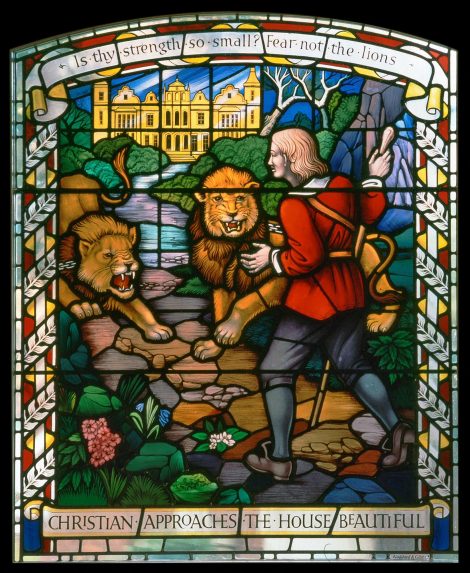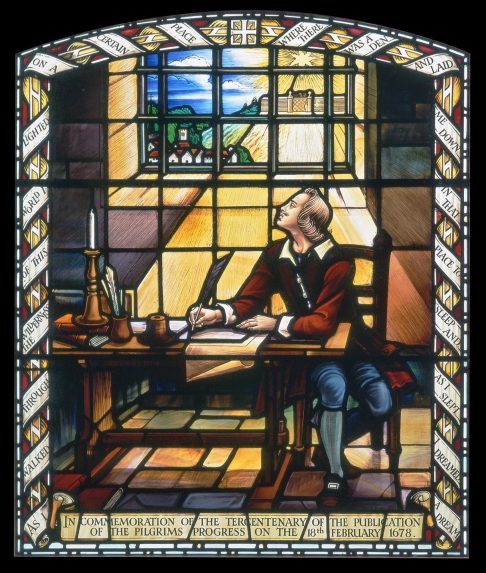Bunyan Meeting House and Museum, Bedford, Bedfordshire
Address
John Bunyan Museum, Bunyan Meeting, Mill Street, Bedford MK40 3EURecommended by
Highlight
Scheme of eight windows illustrating ‘A Pilgrim’s Progress’ by John BunyanArtist, maker and date
Designed by A. E. Buss and made by Goddard and Gibbs Studios 1970s-1990sReason for highlighting
Whilst the design and execution of the windows is not necessarily of the technical brilliance of some other 20th Century examples, its appeal lies in the subject matter. The windows tell the story of some main events in the well-loved book ‘The Pilgrim’s Progress’, a Christian allegory written in 1678 by the Nonconformist John Bunyan, who spent twelve years in Bedford County Jail after his conviction for illegal preaching.
The language of the eight windows is bright and clear, seven consisting of an image, easily understood, of Christian during one of his encounters, together with a quote from the text of The Pilgrim’s Progress.
The eighth window shows John Bunyan himself writing The Pilgrim’s Progress in Bedford County Jail, looking out of the small window towards the town.
A postcard of this window was sent to Terry Waite during his four year imprisonment in Lebanon, 1987-1991.
Artist/maker notes
Arthur Edward Buss (1905-1999) studied at Camberwell School of Art before his apprenticeship to William Aikman, a freelance painter who also worked for James Powell and Sons/Whitefriars. Buss became a freelance designer himself, before being invited to join a new stained glass studio – Goddard and Gibbs – in 1946.
Buss’s style is traditional and robust, which suited post-war taste, and between 1949 and 1961 he designed over 150 windows for churches in England and across the British Empire.
Buss’s work was valued so highly by Goddard and Gibbs’ clients that he was invited back after his retirement to continue to design for schemes he had started in previous years.
Goddard & Gibbs
Founded in 1868 as Walter Gibbs and Sons, a decorative glass firm in Blackfriars, London, the company went through some takeovers and mergers before becoming Goddard and Gibbs in 1938.
After the Second World War the company became a leader in the production of new stained glass windows, aided by excellent designers such as Arthur Edward Buss(1905-1999) and his successor John Lawson (1932-2009). It became the largest glass design and fabrication studio in the UK. A dedicated conservation department was founded in 1994 under the leadership of Drew Anderson.
The studio’s success was further enhanced by Charles Clark, who took over the company in 1978. Charles concentrated on developing an overseas market, and soon Goddards was regularly designing, making and exporting stained and decorative glass for palaces and mosques in the Middle East, cathedrals in Africa, cruise ships in Japan, and Mormon temples across the USA and worldwide. At this time the studios won the Queen’s Award for Industry.
Harry Cardross became senior designer in 1996 and was responsible for the design of Goddard’s contemporary architectural glass commissions, maintaining its worldwide export drive.
The company offered practical training for both graduates and apprentices to the highest standard. Many current independent glass artists owe their success to the opportunities offered by the dedicated staff at Goddard and Gibbs.
Further reading: John Lawson ‘Faith Craft Works and Goddard and Gibbs Studio Ltd’ The Journal of Stained Glass, vol. xxiii (1999), 55-61.



Other comments
Bunyan Meeting House and Museum is open to the public. It has a great programme of activities for families and community outreach. See their website at Bunyan Meeting